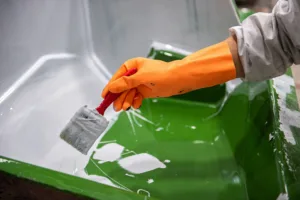When it comes to choosing materials for boat building, construction, or various manufacturing projects, two popular choices are cold molded and fiberglass. Each has its own set of advantages and applications, making them suitable for different needs. Let’s break down the differences between these two materials to help you make an informed decision.

cold molded vs fiberglass
What is Cold Molded Construction?
Cold molded construction involves the process of layering thin strips of wood veneers or planks, which are then coated with epoxy resin. This method uses the strength of wood and the water-resistant properties of epoxy to create a durable and strong structure. The layers are applied over a form, typically made of wood or foam, and once the resin hardens, it forms a solid, one-piece structure.
Advantages of Cold Molded Construction:
- Strength and Lightweight: Cold molded boats are strong and lightweight, making them excellent for speed and fuel efficiency.
- Customization: Since the process involves building over a form, it allows for greater customization in design.
- Repairable: Wood is easier to repair than fiberglass, and damages can often be fixed with simple woodworking tools and materials.
What is Fiberglass Construction?
Fiberglass construction, on the other hand, involves the use of glass fibers woven into a fabric, which is then impregnated with a polymer, most commonly polyester or epoxy resin. This mixture is applied over a mold to take a specific shape. Once cured, fiberglass provides a strong, durable, and lightweight structure that is highly resistant to corrosion, making it a popular choice in many industries.
Advantages of Fiberglass Construction:
- Durability: Fiberglass is extremely durable and resistant to rust, corrosion, and rot, which makes it ideal for boats, cars, and other outdoor equipment.
- Maintenance: Fiberglass structures require minimal maintenance as they do not need regular treatment or painting like wood.
- Consistency: Since fiberglass is molded, it can produce multiple identical pieces, which is beneficial for large-scale production.
Choosing Between Cold Molded and Fiberglass
The choice between cold molded and fiberglass depends largely on the specific requirements of your project:
- Aesthetics and Feel: If you’re looking for a more traditional, wooden appearance with the possibility of customization, cold molded is the way to go. It offers a classic look and can be finished in a variety of ways.
- Production and Costs: For large-scale production, fiberglass is often more cost-effective and quicker to produce, especially when identical units are needed.
- Durability and Maintenance: If your primary concerns are durability and low maintenance, fiberglass offers an excellent solution as it withstands harsh conditions without the need for frequent upkeep.
In summary, both cold molded and fiberglass have their own unique benefits. Your choice will depend on factors like the desired aesthetics, the importance of weight, maintenance considerations, and whether the project involves mass production or a bespoke creation. Understanding these differences can help you select the right material for your needs, ensuring both functionality and efficiency.
 info@unicomposite.com
info@unicomposite.com


























